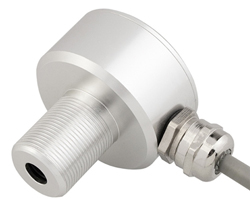Infrared Temperature Sensor Working Principle
Infrared temperature sensor is an IR temperature sensor, its sensitive element and the measured object are not in contact with each other, also known as non-contact infrared temperature sensor. It can be used to measure the surface temperature of human body moving objects, small targets and objects with small heat capacity or rapid temperature changes, and can also be used to measure the temperature distribution of temperature fields.

How does an infrared temperature sensor work?
Infrared temperature sensor is the most commonly used non-contact temp sensor which is based on the law of blackbody radiation. Radiation thermometry includes luminance method (see optical pyrometer), radiometric method (see radiation pyrometer) and colorimetric method (see colorimetric thermometer). Various radiation temperature measurement methods can only measure the corresponding photometric temperature, radiation temperature or colorimetric temperature. Only the temperature measured for a black body (object that absorbs all radiation and does not reflect light) is the true temperature. To determine the true temperature of an object, the surface emissivity of the material must be corrected. The surface emissivity of materials depends not only on temperature and wavelength, but also on surface state, coating film and microstructure, etc., so it is difficult to measure accurately.
In automated production, it is often necessary to use radiation thermometry to measure or control the surface temperature of certain objects, such as steel strip rolling temperature, roll temperature, forging temperature and the temperature of various molten metals in smelting furnaces or crucibles in metallurgy. In these specific cases, the measurement of surface emissivity of objects is quite difficult. For automatic measurement and control of solid surface temperature, additional mirrors can be used to form a black body cavity together with the measured surface. The effect of additional radiation can increase the effective radiation and effective emissivity of the measured surface. Use the effective emission coefficient to correct the measured temperature correspondingly through the instrument, and finally get the real temperature of the measured surface. The most typical additional mirrors are hemispherical mirrors. The diffuse radiation energy of the measured surface near the center of the sphere is reflected back to the surface by the hemispherical mirror to form additional radiation, thereby improving the effective emission coefficient. As for the radiation measurement of the real temperature of gas and liquid media, the method of inserting a heat-resistant material tube to a certain depth to form a black body cavity can be used. The effective emission coefficient of the cylindrical cavity after reaching thermal equilibrium with the medium is obtained by calculation. In automatic measurement and control, this value can be used to correct the measured cavity bottom temperature (i.e. medium temperature) to obtain the real temperature of the medium.
Infrared temperature sensor advantages
The measurement upper limit of the Infrared temperature sensor is not limited by the temperature resistance of the temperature sensing element, so there is no limit to the maximum measurable temperature in principle. For high temperatures above 1800 °C, the non-contact temperature measurement method is mainly used. With the development of infrared technology, the IR temperature sensor has gradually expanded from visible light to infrared.

